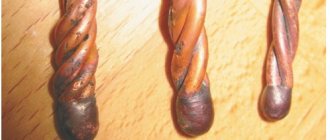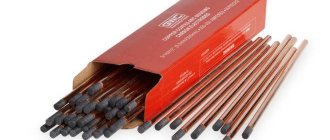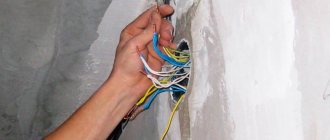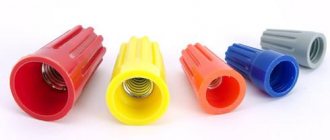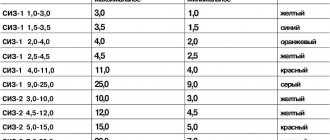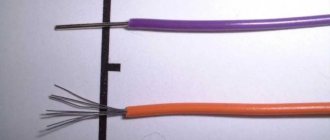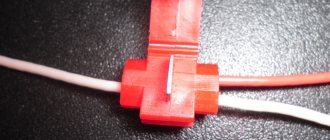When to connect cables
Cable connections will be required in case of poor-quality wiring performed earlier, or due to errors made during installation work. To restore power to the house, you need to connect the electrical wires. You can make a connection in ways that are divided into 2 groups:
- For the first group, no special equipment is required.
- The second group already requires certain skills and professional tools.
Work on connecting cables must be carried out in compliance with safety regulations.
Types of cables for connection
The most common cable for home electrical wiring is a PVA connecting cable, consisting of two insulating layers.
Copper strands, stranded, twisted along the central axis. The wire is flexible, making it great for a variety of connections. The voltage of connected devices must be up to 380 Volts.
The cross section is selected depending on the load:
- for a current of 6 A, PVA with a cross section of 0.75 mm is used;
- for 10 Amperes - the cross-section is 1 mm;
- for currents of 16 A – 1.5 mm.
In addition to the PVS wire, for connection there are multi-core cables ShVVP, PUGNP, PRS, KG. They are used less frequently for home wiring than PVS.
Cap design
The design of the device includes the following components: a cap and a steel spring. The PPE cap is made of plastic, which has electrical insulating properties. This plastic is non-flammable and resistant to high temperatures, and can also withstand a voltage of 600 Volts. These indicators are usually written on the packaging.
As for the spring, it is made of steel in the form of a cone and, with the help of coils, compresses the wire more strongly. The steel spring is additionally treated with an electrochemical protective layer. The dimensions of the spring should be equal to the area of the smallest part of the body where the wire will have maximum contact with another conductor
Therefore, it is extremely important to select the exact dimensions so that the connection is as correct and reliable as possible.
It is worth noting that PPE caps come in two types - with ears and without ears. There are no special differences, but caps with ears are easier to screw onto the wire, and without ears they take up less space in the junction box.
Tags: , machine, beat, sconce, view, harm, choice, house, , clamp, isolate, cable, how, , installation, load, voltage, nominal, crimping, soldering iron, rule, principle, wire, start, , work , size, row, garden, light, lamp, network, twist, connection, wire connection, term, diagram, type, current, , shield, effect
What is the best way to reliably connect two cables together?
Methods of connecting cables that require equipment and skills in the field of electrical engineering:
- soldering;
- welding;
- crimping with sleeves.
Simple connection methods that do not require tools or knowledge:
- connection using terminal blocks;
- spring clamps;
- PPE caps;
- bolted connection.
The choice of connection method depends on the characteristics of the wires. It is necessary to take into account the type and material of the core, the number of wires, and operating conditions.
With soldering
Soldering is a common method of connecting cables. To work you need a soldering iron, rosin, solder and sandpaper. How to connect wires by soldering:
- stripping of insulation;
- cleaning from oxides using sandpaper;
- the conductors need to be tinned - rosin is placed on the wire, it is heated with a soldering iron until the wire is covered with rosin;
- the conductors are assembled together, bubbling rosin must be applied to them and heated until the solder spreads;
- The soldering area is cooled.
The complexity of the process lies in the availability of professional skills. Do not overheat the solder area or twist it when heating, otherwise the insulation may melt. It is important to ensure high-quality and reliable contact of the wires. Soldering is used in low-current electrical applications.
No soldering
Wires are connected without soldering using special connecting elements. It is also possible to connect the wires by twisting. Twisting is the simplest method that does not require equipment, but this method is also the most unreliable.
It is prohibited to use only a twisted connection according to the rules of the PUE.
Copper
Copper wire can be connected using terminal blocks, Wago clamps (necessarily using special paste), using a bolt, or soldering.
Aluminum
Aluminum wires can also be connected using any method, but with some special features. When connecting, the metal must be manually stripped of insulation.
Copper and aluminum wires cannot be connected directly. The connection point becomes very hot and over time the contact weakens. Therefore, it is better to use terminal blocks, wago, bolt connection or special branch clamps.
Choosing an electrical wire for external wiring on the street
When organizing indoor wiring, many people do not think about choosing a wire and often use the first option they come across. When laying outdoors, this approach is unacceptable, because there are a number of negative factors - temperature fluctuations, the influence of UV rays, high humidity, the risk of mechanical stress, and others. That's why it's important to know what wire to use for outdoor wiring and what to consider when installing it.
Is it possible to connect cables by twisting?
According to the rules of the PUE, twisting is prohibited, as it does not provide reliable contact. It can only be used in conjunction with another connection method. It is also unacceptable to use twisting to join two different metals.
Stranded and single-core
When connecting multi-core wires, the following rules should be followed:
- strip the insulation by 4 cm;
- unwind the conductors by 2 cm;
- connect to the junction of untwisted conductors;
- twist the wires only with your fingers;
- You can tighten the twist using pliers;
- bare wires are insulated with special tape or heat shrink tubing.
Twisting solid wires is much easier. They need to be stripped of insulation, twisted by hand along the entire length, then clamped with pliers and insulated.
Twisting methods
You can do twisting in different ways. It can be made by branch, parallel or series connection. Also, to improve the reliability of contact, caps and clamps are additionally used.
Correct twisting of electrical wiring in a junction box
When twisting, you need to follow the following procedure:
- cut off power to a house or apartment;
- clear the wiring of 4 cm or more of insulation;
- unwind the wires by 2 cm;
- connect untwisted wires to the junction;
- twist the veins with your fingers;
- tighten the twist with pliers;
- insulate exposed wires.
Both single-core and multi-core cables can be connected.
Twisting of different sections
Do not twist wires with very different diameters. Such contact is not reliable and stable. You can twist wires of adjacent sections - for example, 4 sq. mm and 2.5 sq. mm. When twisting, you need to make sure that both wires wrap around each other. A thin wire should not be wound onto a thick one, otherwise the contact will be unreliable. Then you need to solder or weld the joint.
Twist caps
The caps help to reliably insulate the contact point.
The cap is made of fire-resistant material, inside it there is a metal part with threads. Making twists using caps is quite simple - you need to remove 2 cm of insulation and lightly twist the wires. A cap is put on them and turned several times until the metal wires are inside.
With terminal clamps
The contact clamp consists of a screw, a spring washer, a base, a current-carrying core and a stop that limits the spreading of the aluminum conductor. Making a connection using a contact clamp is simple - just strip the ends of the wires by 12 mm and insert them into the hole in the clamp. Contact clamps are used for both solid and stranded conductors.
How to brew twist
After twisting, the wires need to be soldered. To do this, the wires are tinned and rosin is applied to them before twisting. The heated soldering iron is lowered into the rosin; it needs to be passed along the stripped part of the wiring. After twisting, take tin on a soldering iron and heat the joint until tin begins to flow between the turns. This method takes a lot of time, but it is reliable and of high quality.
Alternative solutions
In addition to those discussed above, it is worth highlighting a number of other brands of cables used in organizing street wiring:
- PVC is a flexible cable with a PVC sheath and marked wires. The number of cores is from two to five.
- VVG is a power cable with a number of cores from one to five. It is distinguished by its flat shape and double insulation, which allows the wire to be used outdoors .
- PV, APV, PV1 and other wires are suitable for laying external wiring, but only if they are located in pipes. The main disadvantage is the presence of single insulation, which makes them vulnerable to mechanical stress.
- VBBvng is a product characterized by fire resistance and flexibility. The number of cores is from one to six. Most often used to connect portable devices.
After the 2000 Bell Telecom building tragedy in New York City, cable manufacturers changed safety standards. The reason is the release of toxic gases from the braided wires during the combustion process, which is why most people died. In addition, toxic gases also negatively affect complex electronics. That is why at the present stage manufacturers focus on the production of non-flammable wires characterized by low levels of gas and smoke emissions.
Methods for connecting wires or cables to each other
The junction of two conductors must meet the following requirements:
- reliability;
- mechanical strength.
These conditions can also be met when connecting conductors without soldering.
Crimping
This method requires special equipment. Crimping of wires with sleeves is carried out for both copper and aluminum wires of different diameters. Depending on the cross-section and material, the sleeve is selected.
Crimping algorithm:
- stripping of insulation;
- stripping wires to bare metal;
- the wires need to be twisted and inserted into the sleeve;
- the conductors are crimped using special pliers.
Selection of a sleeve causes major difficulties. An incorrectly selected diameter will not ensure reliable contact.
Bolted connection
Bolts, nuts and several washers are used for contact.
The connection point turns out to be reliable, but the structure itself takes up a lot of space and is inconvenient to install. The connection order is as follows:
- stripping of insulation;
- the stripped part is laid in the form of a loop with a diameter equal to the cross-section of the bolt;
- a washer is put on the bolt, then one of the conductors, another washer, a second conductor and a third washer;
- the structure is tightened with a nut.
Using a bolt, you can connect several wires. The nut is tightened not only by hand, but also by a wrench.
Terminal blocks
The terminal block is a contact plate in a polymer or carbolite housing. With their help, any user can connect wires. The connection occurs in several stages:
- stripping the insulation by 5-7 mm;
- removal of oxide film;
- installing conductors in sockets opposite each other;
- fixation with bolts.
Pros - you can connect cables of different diameters. Disadvantages - you can only connect 2 wires.
Types of terminal blocks for multi-core and single-core cables
There are 5 main types of terminal blocks:
- knife and pin;
- screw;
- clamping and self-clamping;
- cap-shaped;
- "walnut" type clamps.
The first type is rarely used; they are not designed for high currents and have an open design. Screw terminals provide reliable contact but are not suitable for connecting multi-core cables. Clamp terminal blocks are the most convenient devices to use; their installation does not require special equipment. Cap-type devices are also often used, but unlike clamping devices, caps can be used repeatedly. "Nut" is practically not used.
Terminals in junction box (copper or metal)
Terminals are the most common connection method in a junction box. They are cheap, easy to install, provide reliable contact fixation and can be used to connect copper and aluminum. Flaws:
- cheap devices are of low quality;
- Only 2 wires can be connected;
- Not suitable for stranded wires.
Self-clamping terminal blocks WAGO
There are 2 types of Vago terminal blocks used:
- With a flat spring mechanism - they are also called disposable, since reuse is impossible. Inside there is a plate with spring petals. When installing the conductor, the petal is pressed out and the wire is clamped.
- With lever mechanism. This is the best connector option. The stripped conductor is inserted into the terminal and the lever is clamped. Re-installation is possible.
With proper use, Vago terminal blocks last 25-30 years.
Using Tips
For connection, 2 types of tips and sleeves are used:
- in the first, the connection is made inside the product;
- in the second, two electrical wires are terminated with different tips.
The connection inside the sleeve or tip is strong and reliable. There are also special sleeves for connecting copper and aluminum wires.
Soldering of electrical wiring lugs
The tips are connected to the wiring using a press.
If it is not there, contact can be ensured by soldering. The electrical wire and the tip inside are tinned, the stripped cable is inserted inside.
The entire structure on the contact must be wrapped with fiberglass tape and heated with a burner until the tin melts.
Which wire to use for outdoor wiring: the best options
We smoothly approached the main question of which wire to use for external wiring in order to be confident in its reliability and ability to withstand negative natural influences. The main requirements for such products are combustion resistance, strength and non-hygroscopicity.
The most popular types include:
SIP is an outdoor power cable capable of conducting voltages up to 1000 V. Structurally, the product is a group of wires with individual insulation and aluminum conductors. Such products have their own subtypes (SIP -1, 2, 3, and so on) and are produced in many countries around the world. The main feature is the black insulation of the wires. The use of such a cable guarantees greater reliability during aerial installation and reduces installation costs. An additional advantage is its compactness, which allows the cable to be used even in conditions of limited space.
AVBbShv is a product based on a group of wires with aluminum cores combined under one armored sheath. One of the cable types is VBBShV - a version with copper wires. A special feature is the possibility of laying in the ground without the use of additional protection and resistance to mechanical stress. Main characteristics:
- The presence of steel tape in the shell.
- The wire insulation is made in different colors for ease of dialing and connection.
- The outer shell is black.
- Resistant to moisture and temperature changes.
- Resource - 30 years.
Due to the presence of armor, cable products of this type are characterized by increased rigidity, which creates additional problems during the installation process.
NYY is a cable characterized by versatility and reliability in operation. May have copper or aluminum conductors. This product is increasingly used for external wiring in the ground or in the air, as well as for connecting electrical receivers indoors. Main characteristics:
- Resistant to water and fire.
- Compliance with international standards.
- Availability of multi-colored wire insulation.
- Convenience of organizing outdoor wiring.
- The outer shell is black PVC plastic.
- Resistant to temperature changes.
- Resource - 30 years.
This cable is produced in many factories due to its versatility and reliability. The main competitor of the product is considered to be the VBBShV cable, which was mentioned above.
NYM is a reliable cable that is actively used in production and outdoor wiring. Its peculiarity lies in its versatility and ability to operate in various conditions. Characteristics:
- Compliance with the standards of the German Electrical Engineers Union.
- Heat resistance and ability to operate over a wide temperature range.
- Non-hygroscopic and durable, which allows the product to be laid in concrete or in a layer of plaster.
- The cross-section is round, the color is gray.
- Fire resistance.
When installing wiring outdoors using NYM, protection from sunlight is recommended. Such cable products are produced at many factories located in Europe and Russia. Some manufacturers produce cables according to individual specifications, but such products have a lower price and, accordingly, worse quality. The use of such cables for external wiring is not recommended.
Connectors for wires and cables
Connectors are special devices that facilitate the connection of two or more conductors. There are screw and clamping mechanisms.
Screw terminals
Used to connect wires of different materials and different diameters. An exception is multi-core electrical wires, which are crimped with special lugs. Also, screw clamps can damage aluminum wires, so it is better not to use them for such material.
Screw terminals
Allows you to connect aluminum and copper conductors together. They are easy to connect.
Power clamp
In such clamps, the stripped conductor is placed in the hole to the end. There it is automatically fixed by a pressure plate. Clamps can be used to secure copper and aluminum wires.
Clips
To install the wire, the clip clamp is placed in a vertical position, the wires are inserted inside, and then the clamp must be moved to a horizontal position. Plus, you can make adjustments.
Spring clamps
PPE caps are used as spring clips. Thanks to them, you can quickly make contact between two wires of similar diameters. It is important to choose the correct clamp, otherwise the contact will be unreliable.
Spring terminals
Wago spring terminals ensure reliable contact quickly and efficiently. However, over time, the spring may weaken or overheat.
Connection clamps
There are two types - electrical and electrical. The only difference is the current load. The connection takes place inside the device.
Couplings
It is made in the form of a metal tube. Used for conductors with a cross section of 0.25-16 mm. The wire is fixed by force crimping. Not used for single-core wires.
Precautionary measures
First, let's talk about what rules you need to follow when insulating cores with your own hands. Firstly, it is strictly forbidden to insulate live wires. You must be sure to turn off the circuit breaker in the distribution panel. Secondly, to protect the connection point, it is necessary to use only materials that comply with GOST standards for insulation and shells. In simple words - do not use plastic bags, tape and other rubbish. For example, for everyone’s favorite PVC insulating tape there is GOST 16214-86, which it must comply with, and specifications based on it.
We strongly advise against using adhesive tape as insulation, because... this material does not have sufficient insulating properties. Now we will look at how to properly insulate wires at home, and will also provide you with the most reliable insulating materials.
Safety Tips and Rules
Only craftsmen with a qualification group are allowed to weld.
Persons who have skills in working with a soldering iron are also allowed to solder. Cables may only be connected in the manner permitted for them. Do not work with damaged wiring. All exposed parts must be insulated.
You can connect the cables in different ways. The choice of connection method is determined by the material, cross-section diameter and other parameters. For electrical equipment to operate correctly, the conductors need to be connected securely. In case of unreliable contact, there is a risk of fire.
Brief recommendations on the installation method
Another factor that must be taken into account is the installation method. The most popular options:
- Air. This option is suitable for cases where the cable has a length of 3 meters or more. The advantages of the method are high installation speed and ease of maintenance. On the other hand, aesthetics suffer and the service life of the product decreases. In the process of such installation, a steel cable is used, to which the cable itself is attached using ties.
- Underground. This method is used in most cases when it is necessary to lay a long cable. Installation is carried out in several stages - choosing the cable type, marking the location and laying it. The depth of the trench is about 70 cm. At the bottom there should be a “cushion” of sand about 8-10 centimeters thick. The cable must be laid without tension, after which it is covered with sand, soil and finally compacted.
An example of cable laying in a trench is shown in this video:
